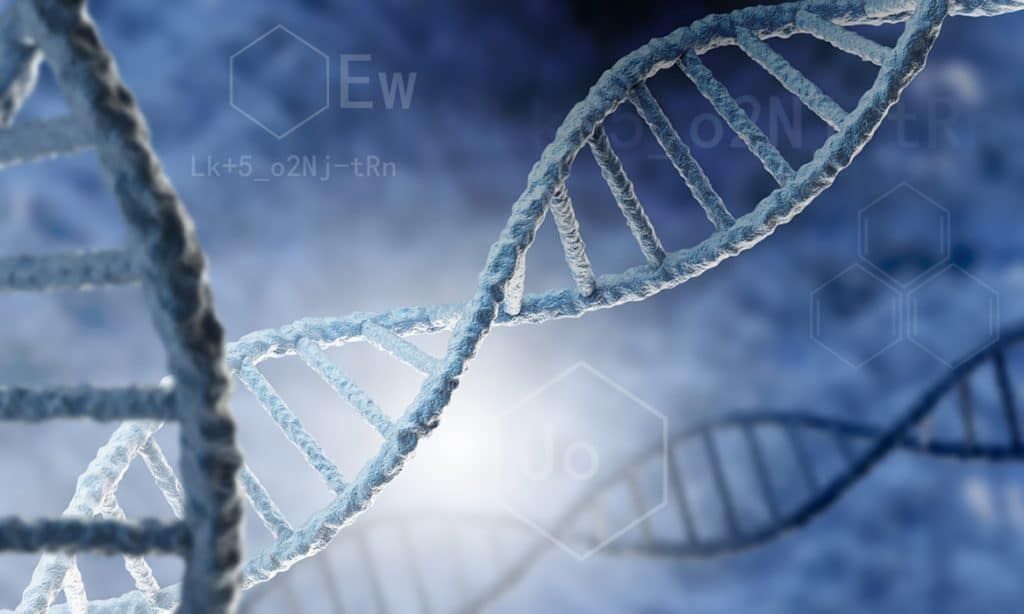Inside a lab trying to develop a coronavirus vaccine
By Helen Santoro | March 19, 2020
 Artist's representation of DNA molecule. Image courtesy of Shutterstock
Artist's representation of DNA molecule. Image courtesy of Shutterstock
Editor’s note: This story was originally published by High Country News. It appears here as part of the Climate Desk collaboration.
In a tall building on the outskirts of downtown Seattle, a group of scientists from the University of Washington’s Institute for Protein Design huddle in front of computers, concentrating on their screens. Using a special program, they’re tinkering with building blocks of proteins, taking the first of many steps to develop a vaccine for the new coronavirus SARS-CoV-2. [Just like the distinction between HIV and AIDS, where HIV is the virus and AIDS is the disease it can lead to, SARS-CoV-2 is the virus, and COVID-19 is the disease it can cause.]
Creating a working vaccine is challenging and will likely take over a year, at best. But with Seattle at the heart of the coronavirus outbreak in the United States—as of March 13, the state had seen 568 cases and 37 deaths, numbers almost certain to rise as more people are tested—this task is the top priority for the scientists. “We’ve put a lot of projects on hold so that we can focus on this,” said Brooke Fiala, a vaccine researcher who leads the institute’s nanoparticle laboratory.
In order to fight the coronavirus, scientists from universities and drug companies around the world are developing vaccines, using a variety of methods. Some labs are manipulating the early stages of protein development, while others are working with dead versions of the virus. Fiala and her colleagues are taking a different approach: manufacturing nanoparticles to create a more efficient vaccine.
Vaccines expose the body to an antigen, which is a small dose of virus or bacteria parts. The antigens trigger an immune response: The body’s immune cells produce antibodies, which combat the invader and protect against further infection. There are several ways to create a vaccine. In one common method, for example, scientists weaken the virus so that it reproduces very poorly once inside the body, giving the immune system time to make antibodies.
In Fiala’s lab, scientists are instead attempting to form what is called a nanoparticle. The shape of this microscopic particle must allow for an antigen called a spike protein—the part of the SARS-CoV-2 virus that allows it to infect human cells—to fuse to the outside. If all the pieces fit together properly, the resulting molecule should look like a spiky ball, with the nanoparticle at the core and the spike proteins protruding outward. Once perfected, this spiky ball can become a vehicle for introducing the viral proteins to human cells and stimulating the immune system.
The first step in making a nanoparticle vaccine involves designing a promising nanoparticle model using a computer, manufacturing the DNA that codes for its shape, and then transferring that DNA into E. coli bacteria. The bacteria follow the DNA’s instructions to form the correct protein. Researchers then burst open the bacteria and extract the newly made protein, which spontaneously folds into the desired nanoparticle—each piece of the molecule exactly where it should be. Finally, multiple spike proteins are attached to the outside of the nanoparticle, creating the spiky ball. The immune system reads repetitive arrangements like this as a sign of peril and responds by rapidly creating antibodies.
This type of vaccine is thought to be more powerful than other varieties; the nanoparticle is highly effective at stabilizing the spike proteins and inducing an immune response. And while it’s been in use since around the 1980s, engineering a nanoparticle on a computer is a big step forward. “The use of computational models to predict and design self-assembling proteins is a recent breakthrough in nanoparticle vaccine design,” said Emma Kate Loveday, a virologist at Montana State University.
It’s a complicated process, but after a recent success in generating a nanoparticle vaccine for respiratory syncytial virus, a contagious respiratory infection, Fiala is hopeful. “We’ve become quite practiced,” she said. “We’re very used to this process of taking those antigens and putting them on nanoparticles.” So far, they have ordered 18 different nanoparticle DNA sequences and are confident that one of these variations will eventually lead to a successful vaccine.
In the upcoming months, the team hopes to get a vaccine to animal trials. If all goes well, the vaccine will then be tested in humans. Making sure it’s safe and effective enough for widespread use could take a year or longer, though. Science often appears to move at a frustratingly slow rate, especially when something as serious as the coronavirus is spreading so quickly, said Ian Haydon, the scientific communications manager for the Institute of Protein Design. “But science like this needs to move slowly in order to make the proper drugs to save lives.”
Together, we make the world safer.
The Bulletin elevates expert voices above the noise. But as an independent nonprofit organization, our operations depend on the support of readers like you. Help us continue to deliver quality journalism that holds leaders accountable. Your support of our work at any level is important. In return, we promise our coverage will be understandable, influential, vigilant, solution-oriented, and fair-minded. Together we can make a difference.
Keywords: COVID-19, Coronavirus, biosecurity, vaccine, virus
Topics: Analysis, Biosecurity, Disruptive Technologies















